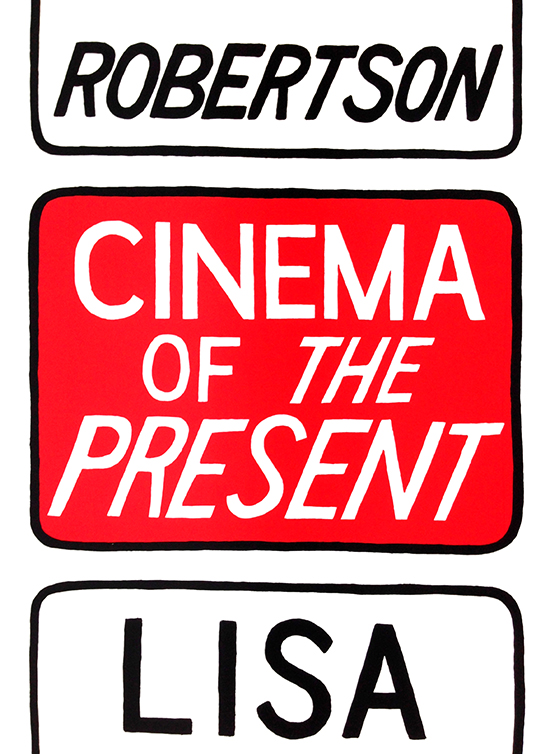Is it any good is the wrong question; how is it changing the terms of our enjoyment is the right one. Cinema of the Present is a threshold experience I pin brilliant. It bites the fruit it invents and brains us, tingling. It is behind-the-scenes, pink wrench-work: It is an action on us. Now. —Natalie Helberg
Cinema of the Present
Lisa Robertson
Coach House Books
112 pages, Paperback ($17.95)
ISBN: 978-1552452974
.
Lisa Robertson’s Cinema of the Present arrives lean and reels in intellection. It’s delicate and circumspect and gutsy at once. Like so much of her work, it astonishes the sentence. It is an attempt to pressure writing away from habitual crutches, as in the trappings of the heavy hitters, not just what we learn in Poetry 101. It is eclectic, rarified, and dense, scatterbrained and philosophical: It tells us that the stakes of writing are high, that writing sculpts subjects as much as it sculpts the domain they dwell in, and that, consequently, there is no trick-bag to rely on, no set of writing techniques we can master and remain content with. Robertson claims that she does not know how to write, each time, then begins. Cinema of the Present attests to this attitude: Writing, it insists, is the attempt to write itself: it is humility, excitation, and persistent process. It is integrity and risk.
While much of Robertson’s work—The Apothecary (1991), Debbie: An Epic (1997), XEclogue (1993), Occasional Work and Seven Walks from the Office for Soft Architecture (2003), Nilling (2012), and many, many other collections—embrace a lush, amped-up take on the sentence (the baroque), Cinema of the Present proceeds comparatively economically. It is close to Robertson’s 2010 work, R’s Boat, which in many ways anticipates it.
Robertson’s ‘baroque’ can seem semantically impenetrable: It arises from the creative ‘verbing’ of nouns—“rooms with no middle ground, differently foxed” (Occasional Work)—the use of “improper” adjectives—“Don’t be afraid tulip for time is fat / with our indiscretion” (Debbie)—general adjectival lavishness, or a more general clashing of unlikely but suggestive sentence-parts: “Loose-armed impostors, we’ll hone an incendiary calendar, from the still bosco contrive the days that shall give us History, that saline, perplexed crux: Day of Parked Cars; Day of Physical Secrets; Day of Consonant’s Lip; Day of Lucite…” (XEclogue). But it can also seem exquisitely clear and referential: “[A]nd then the theorist sauntering purposefully from her round hips, her heavy leather satchel swinging like an oiled clock” (Occasional Work).
If Robertson’s language-based interventions are at times rogue and rude, they are also well-informed. Robertson is somewhat of an extinct species, a bit of a Virginia Woolf figure, one of those rare writers who has had a chance to devote her life more or less exclusively to reading and writing, without the intrusion of anything like regular employment. She’s someone who’s survived by being innovative, by being communally embedded, and by scrounging.
She spent years living rent-free in a cabin on Saltspring Island, during which she gobbled up Phyllis Webb, Heidegger, Barthes, Jean Genet, Ezra Pound, and Proust, among others. She is well-read in general, and her influences are as myriad as they are motley: Virgil, Plath, Lyn Hejinian, Rilke, Lucretius, Susan Howe, bpNichol, etc. She was involved with the Kootenay School of Writing in Vancouver for several years in the nineties, where she became acquainted with key figures in the American Language movement as well as Russian Formalism (Viktor Shklovsky and his injunction to quicken perception by defamiliarizing language), post-structuralist theory, and feminist criticism. Before the Kootenay School, she attended Simon Fraser University, where she took courses from writers like George Bowering and Roy Miki and studied the Canadian avant-garde (a few names to mention: The Four Horsemen, Erin Mouré, and Nicole Brossard).
Of her early, baroque approach to the sentence, Robertson has said: it is a pursuit of a particular internal sound-structure, an attempt to produce a “full knobbly quality, or a torsion or a jaggedness or a swoony kind of movement from syllable to syllable.”[1] The resultant sentences may not mean in conventional ways, but the fact that they do not only serves another of Robertson’s professed aims: to create sentences that startle, and, in startling, produce new emotional and intellectual terrain.[2] The aesthetic Robertson adopts in Cinema of the Present is less gnarly, and yet it still glimmers; it finds alternative ways to invigorate language:
You are fundamentally forgotten and veiled or you are deeply erased and diverted.
It was a place like the farm, but near the ocean.
You were poverty shivering in an old turquoise city.
(from Cinema of the Present)
The intention animating Cinema of the Present is related: the piece is an attempt to construct a pronoun. The confessional voice that invokes the ‘lyric I’ risks sounding cliché and cheesy, but any work’s organizing pronoun, says Robertson, is in danger of becoming the site of formulaic, dry, taken for granted language; we need to trouble that site if we’re going to keep it. Cinema of the Present troubles its organizing pronoun by making it self-thematizing.
The text begins: “What is the condition of a problem if you are the problem? / You move into the distributive texture of an experimental protocol.” ‘You,’ the pronoun, a few lines down, sets “out from consciousness carrying only a small valise.” The poem, which consists of a hundred or so pages of double-spaced, one-line statements (sometimes questions, sometimes fragments), some of which are repeated in slightly altered form at irregular intervals, continues:
A downtown tree, the old sky, and still you want an inventory.
You were an intuition without a concept.
A gallery, a hospital, an hypothesis.
Pure gesture.
Many of the poem’s subsequent lines likewise explicitly qualify this ‘you’: “You are the silence they exchanged,” “You are a transitional figure who sees yourself as such,” but many do not. As in the above (“A gallery, a hospital, an hypothesis”), some are fragments which refer to the perceptual world, or just the world more broadly (“Atoms, theatres, famines”), and yet the pronoun/subject, situated with its valise at the frontier of consciousness, arguably absorbs them:
Each line that makes up the poem, though it can function independently, can also be read forward and backward (as in ‘you were an intuition without a concept: a gallery, a hospital, an hypothesis, pure gesture’); meaning can cascade forward or backward as many lines or as few as suits a reader’s fancy (you were ‘a hospital, an hypothesis, pure gesture,’ and, as the next line goes, “a gate made of carpet tape”). The poem posits consciousness as spongiform and figures poetry and poetic practice as a gate between subjectivity and objectivity. The “gate made of carpet tape” recurs throughout the poem as a figure for the mind’s immersion in the perceptual vista: it is a gate constituted by all manner of encountered materials: it becomes “a gate made of gas pumps,” “a gate made of bread and screws.”
The subject/pronoun the poem is preoccupied with, then, both surges up from and recedes back into language (“Your pronoun leaks thus”). The statements or fragments that seem to concern it least still become its tissue, and the pronoun, conversely, becomes the poem itself (“It was not your voice at all, but it can’t stop nor does it think”). It is this pivot which allows the poem to produce its meta-commentary: By the time we get to the line “You are banality,” or “You are no longer aesthetical,” for example, we can read these lines as referring to the poem itself. Besides its pronoun-anxiety, Cinema of the Present shares with R’s Boat, its precursor, a willingness to embrace what Robertson refers to as either flat, outright bad, or banal sentences, a willingness, in other words, to embrace everything—“What you wanted: total, gestural plasticity”; “You presuppose a free, opened and unlimited space”— while sequencing these materials in such a way that they come to work aesthetically (which sometimes means that the resulting arrangement has actually opened up a new aesthetic possibility: “at the edges of banality, there is sensing”).
Sequencing may be one of the keys to Robertson’s title, as well: In “The Work of Art in the Age of Its Technological Reproducibility,” Walter Benjamin notes that a reality presented through film, which is pure in the sense that it bears no sign of the technology used to produce it, is only pure in this sense because technology has purged it, has edited itself out, cutting shots and assembling shots taken at different times, while mindfully orchestrating transitions between them. Robertson has used the essay in the past to stress the extent to which writers—and this reflects a deep dimension of her own approach—are mindfully patterning, or texturing, a linguistic surface; they are arranging materials, and, like filmmakers, are orchestrating transitions between the text’s moments. The double-spaced lines which make up Cinema of the Present, the arrangement of this text as an uninterrupted sequence of these lines, and the arrangement of these lines themselves make the text, perhaps more than her other works, the book-analogue of film. It exists as the effect of a complex form of visual reduction, as well as of a cinematic sensitivity to time and rhythm.
Gertrude Stein’s “Composition as Explanation,” in which Stein offers an elusive articulation of her own approach to composition, “writing the present,” provides another insight into Robertson’s title. “Writing the present” à la Stein involves, among other things, an attention to time in the work, which is the effect of “distribution and equilibration,” or what, in keeping with the above, we might call sequencing. “To construct a velocity is what you want” (Robertson). It also entails “using everything” (as in the way both R’s Boat and Cinema of the Present do) “by beginning again and again” (Cinema of the Present, like much of Stein’s work, unfurls along descriptive axes—it makes reference to the sensory world, but also to the project itself, its pronoun and the act of writing it—and does so in a playfully repetitious manner).
Stein’s essay also affords a pre-echo of Cinema’s open-ended spirit and structure. Robertson writes, “Curiosity, limbs and momentum: because of form you kept playing,” “You carried the great discovery of poetry as freedom, not form,” and “If you speak in this imaginary structure, it’s because other choices felt limiting.” Stein writes “No one thinks these things when they are making…no one formulates until what is to be formulated has been made” and “Composition is not there, it is going to be there and we are here.”
The open structure that characterizes Cinema of the Present and the vocabulary that Robertson has let loose in the work are also relevant to the work’s thematic content. The diction in Cinema is drawn in part from philosophical sources. There is explicit reference to Nietzsche and Aristotle, an injunction, at one point, to eliminate all contradictions (which is contradicted), and the repeated mention of “the indispensable horizon of all that occurs or appears.” There is even a possible reference to Foucault, the great theorist of disciplinary spaces: “Thus you were led to describe hospitals, prisons, remote villages, monasteries.” And to Hannah Arendt: “So you came to nilling” (nilling being a passive form of willing, or an active form of not-willing).
Robertson has used Arendt as fodder before, in an essay on Pauline Réage’s controversial Story of O. In the novel, the eponymous protagonist, O, is made into a sex slave; more specifically, her boyfriend asks her to be a slave whom many other men—provided they are ring-bearing members of a certain salacious organization (at Roissy)—can make use of as his proxies. O is subjected to excruciating forms of corporeal torture; her body is mutilated, assiduously penetrated, yet at every moment she agrees to her treatment: she submits herself to it. Robertson reads Story of O as an allegory for the formation of the subject through the paradoxical form of agency that is nilling: the subject’s self-conscious self-submission to a power beyond itself (an Other), as occurs in the act of reading, during which the reading subject gives itself over to, and is transformed, however violently or benevolently, by text.
Cinema of the Present, seems, at times, to refer to this reading: It makes mention of “O, Rosy-booted.” Its organizing pronoun is said to want “to wear the feathered mask of a owl” (at the height of her subjection, O is shaved, attached to a dog-leash, and displayed naked at a party wearing just such a mask; she is afterward desecrated in the mask, on a table, as the sun comes up). The degree of permissiveness that characterizes Cinema as a curated space (it embraces banality, and anything: “What you wanted: total, gestural plasticity”), its ‘openness,’ aligns the work with Story of O (something like Robertson’s take on it), as well. O is obligated, as a slave, ordered, to remain ‘open’: her lips must remain parted at all times, for penetration, as must her legs. Cinema of the Present marks itself as likewise radically accommodating, and accommodating in such a way as to enable self-change. “Your problem is again your own transformation,” it says. “You are a transitional figure who sees yourself as such.” “Once again you acquire a new surface.”
Robertson’s whole enterprise is in this way encapsulated in Cinema. The work is concerned with writing’s (contingent and alterable) conditions of possibility, as well as with the subjective possibilities which are related to them. What it is possible to write, in a given time and place, is an index of what it is possible to be, since it is a subject who writes, or since writing is, ultimately, a subject’s possibility. To alter writing is to alter subjectivity: “Only the rhyme of discourse transforms you,” Cinema says. “Still,” it says, “you’re totally in love with subjectivity,” and “Still, at this late date in the political, you remain intrigued by fucking”:
O is fucked by her Other, entered, conditioned and created and, as a subject, beholden. Cinema is open to an Other that takes the form of un-aesthetical, flat-toned language, and, in being so open, is engaged in producing a counter-pressure to a second Other: ‘writing proper.’
In challenging and altering literary norms, Robertson has also produced new possibilities for the legitimate use of language, for language practices, and for the subjectivities that are what they are partly because they engage in these practices. Cinema of the Present persists with this Sisyphean endeavour: “It’s time for your late style”; “That your mouth lovingly damaged the language”; “You would like thought to release something other than laboratory conditions.” Is it any good is the wrong question; how is it changing the terms of our enjoyment is the right one. Cinema of the Present is a threshold experience I pin brilliant. It bites the fruit it invents and brains us, tingling. It is behind-the-scenes, pink wrench-work: It is an action on us. Now.
— Natalie Helberg
.
Natalie Helberg completed an MFA in Creative Writing with the University of Guelph in 2013. She is currently studying philosophy at the University of Toronto. Some of her experimental work has appeared on InfluencySalon.ca and in Canadian Literature. She is (still) working on a hybrid novel.
Lisa Robertson is one of Canada’s most celebrated experimental poets. She is associated with Vancouver’s Kootenay School of Writing but also resists being associated with any particular aesthetic. Her chapbooks, one-off essays, pamphlets, and scattered poems are too numerous to list here. Her books include The Apothecary (1991), XEclogue (1993), Debbie: An Epic (1997—a finalist for the Governor General’s award in 1998), The Weather (2001), Occasional Work and Seven Walks from the Office for Soft Architecture (2003), The Men: A Lyric Book (2006), Magenta Soul Whip (2009), R’s Boat (2010), Nilling: Prose Essays (2012), and, most recently, Cinema of the Present. She currently lives in France.
.
.


